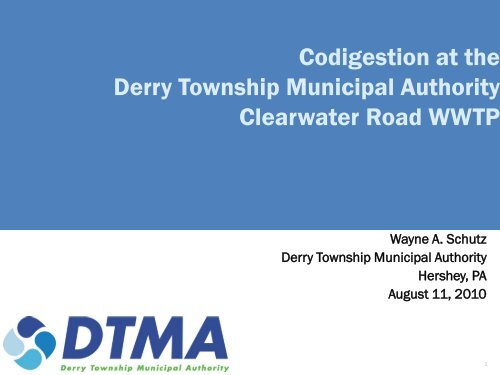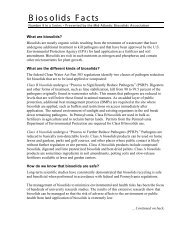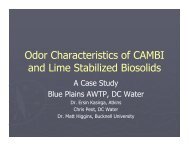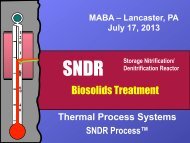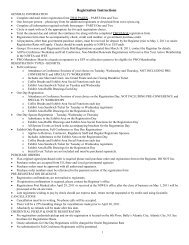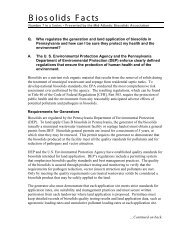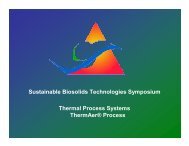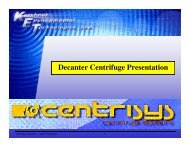Codigestion at the Derry Township Municipal Authority Clearwater ...
Codigestion at the Derry Township Municipal Authority Clearwater ...
Codigestion at the Derry Township Municipal Authority Clearwater ...
You also want an ePaper? Increase the reach of your titles
YUMPU automatically turns print PDFs into web optimized ePapers that Google loves.
<strong>Codigestion</strong> <strong>at</strong> <strong>the</strong><strong>Derry</strong> <strong>Township</strong> <strong>Municipal</strong> <strong>Authority</strong>Clearw<strong>at</strong>er Road WWTPWayne A. Schutz<strong>Derry</strong> <strong>Township</strong> <strong>Municipal</strong> <strong>Authority</strong>Hershey, PAAugust 11, 20101
DTMA Organiz<strong>at</strong>ional Overview• Oper<strong>at</strong>ing <strong>Authority</strong> – Staff of 32• Two Wastew<strong>at</strong>er Tre<strong>at</strong>ment Facilities– Clearw<strong>at</strong>er Road WWT• 5.02 MGD– Southwest WWTP• 0.6 MGD• Unmanned S<strong>at</strong>ellite WWTP• Thirteen Pumping St<strong>at</strong>ions• 150+ Miles of Sanitary Sewer– 6” to 48”
DTMA Clearw<strong>at</strong>er Road WWTP
Clearw<strong>at</strong>er Road WWTPProcess Flow Diagram
Major ComponentsWastew<strong>at</strong>er Tre<strong>at</strong>ment• 5.02 MGD Activ<strong>at</strong>ed Sludge– Wastew<strong>at</strong>er Pumping– Preliminary Tre<strong>at</strong>ment– Screening & Grit Removal– Septage Receiving St<strong>at</strong>ion– Primary Clarific<strong>at</strong>ion– Activ<strong>at</strong>ed Sludge Mechanical Aer<strong>at</strong>ion– Biological Nitrogen Removal (Chesapeake Bay compliant)– (anoxic ~ oxic ~ anoxic ~ re-aer<strong>at</strong>ion)– Ferric Chloride (FeCl 3 ) Addition for “P” Removal– Enhanced Final Clarific<strong>at</strong>ion– UV Disinfection
Major ComponentsSolids Processing• Sludge / Biosolids Processing Facilities– Gravity Thickening - Primary Sludge– DAF – WAS– Hershey IPF Sludge– Anaerobic Sludge Digestion (two stage)– Centrifuge– Indirect Paddle Dryer– Biosolids Storage Pad– SteadiGro, Class A – “EQ” Product Beneficial Reuse
Solids Handling2009 Sludge Production• 9.1 DT/D Raw– 5.7 DT/D (63 %) Primary Sludge– 1 DT/D (12%) Septage/Grease Pretre<strong>at</strong>ment MLSS– 2.2 DT/D (24%) WAS– 1 DT/D (11%) IPF Sludge (anaerobic raw)– 0.2 DT/D (2.2%) DTMA SW WAS• 4.1 DT/D Digested• 55% Reduction
Septage Receiving• Septage Receiving– Started in August 1991• Current Receiving St<strong>at</strong>ion– Two Lane– Hauler Kiosk & DTMA Oper<strong>at</strong>or St<strong>at</strong>ion– Lime addition to settle load in primaries– Screening & Grit Removal via WWTP Headworks• 2009 Totals – 20.6 MG• Septage - 13.85 MG [~48,400 GPD]• Grease Trap Wastes - 5.89 MG [~20,600 GPD]• Misc. Sludges - 0.81 MG [~2,800 GPD]
Septage ReceivingFacility Layout
Greasetrap Pretre<strong>at</strong>mentGenesis• Originally Refused Grease Trap Wastes– Grease was loosely define as 750 mg/l FOG• Grease Trap Acceptance “Morphing”– Accepted GTW from <strong>Derry</strong> Restaurants– Requested GTW be diluted• Problems 2– Build up of Grease on Primary Clarifier baffles, weirs,beaches & in <strong>the</strong> PC center wells.• 30 – 40 CY removed from each PC every 3 months– Plugging Primary Sludge Line• Tear down & flush line every month– Visible grease “specks” in digested BFP cake
• Accumul<strong>at</strong>ion in Scum Pit– Genesis of pretre<strong>at</strong>ment idea– Pilot “Digestion” in Scum Pits– Bugs, soda ash, & mixing/aer<strong>at</strong>ionGreasetrap Pretre<strong>at</strong>mentGenesis• Design Concept for Aerobic Grease Pretre<strong>at</strong>ment– KISS– Incorpor<strong>at</strong>e into existing septage receiving st<strong>at</strong>ion– Provide 48-72 Hours of detention (40,000 gal tank)– Computer controlled fill & draw• Decant MLSS to WWTP Headworks
Greasetrap Pretre<strong>at</strong>mentGenesis• Design Concept (continued)– Chopper Pump• Venturi Aer<strong>at</strong>ion• Rotomix Mixing Nozzles– pH Adjustment (original)• Manual control• Lime Addition– pH Adjusment (current)• Autom<strong>at</strong>ic control via pH probe• Magnesium Hydroxide– Addition of Bacteria• ECOBIONICS Biogener<strong>at</strong>or bacteria delivery system
Greasetrap Pretre<strong>at</strong>mentProcess Flow Diagram
Greasetrap Pretre<strong>at</strong>mentProcess Schem<strong>at</strong>ic
Greasetrap Pretre<strong>at</strong>mentPerformance• Immedi<strong>at</strong>e & Dram<strong>at</strong>ic Results throughout WWTP– Within a few weeks grease buildup through out <strong>the</strong> WWTPwas gone.– Within a few months grease “specks” in BFP cakedisappeared.• Change in delivery philosophy– Requested concentr<strong>at</strong>ed and if possible dedic<strong>at</strong>ed greasetrap loads.– “Adjusted” r<strong>at</strong>es to enhance cooper<strong>at</strong>ion
• Improvements– Grinder/macer<strong>at</strong>or on truck discharge to AGP– Addition of rock trap in front of macer<strong>at</strong>orGreasetrap Pretre<strong>at</strong>mentWork in Progress– Addition of pH control for magnesium hydroxide feed– Scum / Foam Control• Cannot oper<strong>at</strong>e system <strong>at</strong> optimal conditions of pH 7 and D.O. 1 or<strong>the</strong> foam/scum problem becomes uncontrollable• Mission impossible
Greasetrap Pretre<strong>at</strong>mentImpact of <strong>Codigestion</strong>• Greasetrap MLSS is discharged into headworks with PlantInfluent– Screening & Grit Removal• Settles out as Primary Sludge• Anaerobic digester feed stock– High Vol<strong>at</strong>iles– Very good alkalinity• Impact of Biogas Production– Because of all <strong>the</strong> variables involved in <strong>the</strong> digestion of sludge and <strong>the</strong>subsequent gener<strong>at</strong>ion of methane, it is very difficult, to establish aquantit<strong>at</strong>ive rel<strong>at</strong>ionship between <strong>the</strong> amount of grease wastesreceived and <strong>the</strong> volume of methane produce, but clearly arel<strong>at</strong>ionship exists.
Impact of <strong>Codigestion</strong>Before Greasetrap Pretre<strong>at</strong>mentBIOGAS PRODUCTION vs. GREASETRAP WASTE VOLUME ACCEPTED700BIOGAS PRODUCEDGREASE ACCEPTED600SCALE AS NOTED5004001,000 GALLONS / MONTH30010,000 CF / MONTH20020032004 2005J F M A M J J A S O N D J F M A M J J A S O N D J F MMONTH
Impact of <strong>Codigestion</strong>After Greasetrap Pretre<strong>at</strong>mentSCALE AS NOTED650600550500450400350300250UNITSTART-UPBIOGAS PRODUCTION vs. GREASETRAP WASTE VOLUME ACCEPTEDMETHANE PRODUCED1,000 GALLONS / MONTH10,000 CF / MONTH2001502005 20062007 20082009M J J A S O N D J F M A M J J A S O N D J F M A M J J A S O N D J F M A M J J A S O N D J F M A M J J A S O N DMONTH
Biogas Utiliz<strong>at</strong>ionHistory• 2000 - ES Anaerobic Digester On-line• 2001 - Biogas utiliz<strong>at</strong>ion study– No favorable PPL r<strong>at</strong>e structure– Green Energy not yet in vogue– Phase aligned induction gener<strong>at</strong>or not yet common• 2003 – Plan B– Use biogas to produce steam and dry biosolids intoSTEADIGRO Class A, EQ Product for sale– Some biogas wasted• 2007 – Install Centrifuge– 50% reduction in biogas use due to increased cake solids– Increased biogas production from grease acceptance
• 2008 - Biogas utiliz<strong>at</strong>ion for CHP– PPL r<strong>at</strong>e caps off – 20-30% r<strong>at</strong>e increase– Green Energy / REC’s– Recovered waste he<strong>at</strong> for building he<strong>at</strong>– Payback ~ 8½ yearsBiogas Utiliz<strong>at</strong>ionHistory• 2009 – Cogen & Gas Conditioning Design & Bid– Award Contract ($2,200,000) & Notice to Proceed - July– $500,000 PA Green Energy Works (ARRA/DOE) Grant –December• 2010– Unit start-up June 8 th
• Annual CHP Forecast– Electric Power• 1.5 MW Power Production• Approxim<strong>at</strong>ely 20% of WWTP consumption• $150,0000 savings @ $0.10– Recovered He<strong>at</strong>• 20,000 gallons of #2 fuel oil saved• $47,000 savings (@ $2.365/G)– System O & MBiogas Utiliz<strong>at</strong>ionProjected Performance• Two year bumper to bumper including PMs for Gas Skid & Engine– Payback with Grant• ~6.5 years
Biogas Conditioning
Cogener<strong>at</strong>ion Engine
Cogener<strong>at</strong>ion EngineInside <strong>the</strong> “Box”
Cogener<strong>at</strong>ion EngineConnectionsHe<strong>at</strong> Recovery ConnectionsWaste He<strong>at</strong> Radi<strong>at</strong>or
CONVERTINGWASTEBIOGAS INTOPOWER &HEAT


